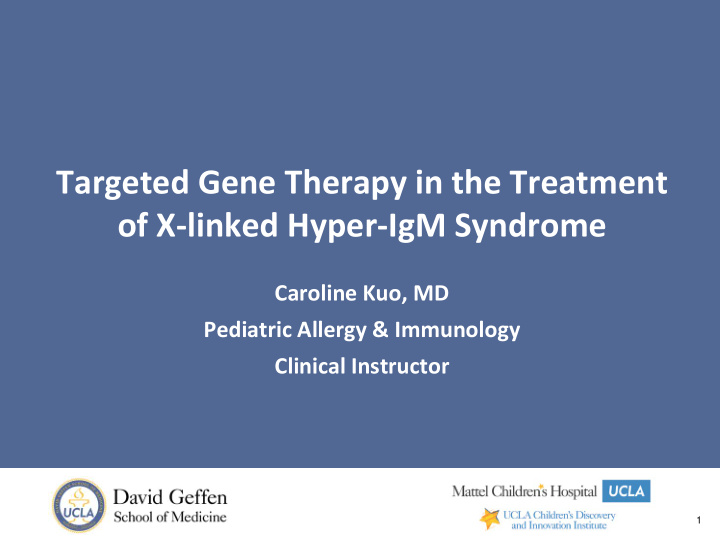



Targeted Gene Therapy in the Treatment of X-linked Hyper-IgM Syndrome Caroline Kuo, MD Pediatric Allergy & Immunology Clinical Instructor 1
Disclosures • None.
Hyper-immunoglobulin M syndromes • Heterogeneous group of genetic disorders resulting in defects of immunoglobulin class switch recombination +/- defects of somatic hypermutation B cell Clinical Presentation CD40 o Bacterial sinopulmonary AR CD80/ 86 α 1 β 1 infections α 2 β 2 CD40L o Pneumonias X-linked V α V β CD28 C α C β o Gastrointestinal infections T cell
Prognosis & Treatment • Concerns with HSCT • Reactivation of occult cryptosporidial infection • Preexisting lung damage • Graft-versus-host disease • Unstandardized conditioning regimen • Timing Levy et al. , 1997 .
CD40L Defects as a Candidate for Gene Therapy Notarangelo L & Hayward A, 2000.
Gene Therapy For XHIM
Rationale • CD40L gene is tightly regulated and requires expression in its normal chromosomal context • Hypothesis • Site-specific gene modification of the CD40L gene in human hematopoietic stem/progenitor cells will correct XHIM • Site-specific endonucleases • Target specific DNA sequences for gene modification • Allow physiologic expression of the corrected endogenous CD40L gene
TALENs • TALENs (transcription activator-like effector nucleases) • Tandem near-identical 34 AA repeats which recognize one base pair via two adjacent AAs (12 and 13) termed repeat-variable diresidues FokI (RVDs) FokI • Fused to catalytic domain of the FokI nuclease to create targeted DSBs Cermak et al., 2011.
Targeted CD40L Gene Insertion TALEN binding site Exon1 Intron 1 E/P Double-stranded break (DSB) E/P Non-homologous end joining (NHEJ)
Targeted CD40L Gene Insertion TALEN binding site Exon1 Intron 1 E/P Double-stranded break (DSB) E/P hCD40L pA cDNA Homology Directed Repair (HDR) hCD40L pA cDNA hCD40L E/P pA Exon1 cDNA
TALENs Introduce Site-specific DSBs at the CD40L Locus in K562 Cells TSS 5 ’ UTR CD40LG Exon1 Promoter Neg. GFP Pos. [TALEN] 22% 31%
GFP Donor as a Model of Targeted Gene Addition in Jurkat Cells Exon1 E/P GFP pA GFP Donor Only % G F P SSC GFP TALEN + GFP Donor % G F P SSC GFP
PHA-L Stimulation of Electroporated Jurkat Cells Increases GFP Expression 0.1 ug/mL PHA 0.3 ug/mL PHA 1 ug/mL PHA 3 ug/mL PHA No PHA 7.8% 1.5% 11.6% 2.2% 38.1% 6.4% 56.4% 11.5% 63.3% 15.8% CD40L 6.8% 7.2% 7.7% 7.5% 6.2% GFP % G F P
Targeted CD40L cDNA Addition in K562 Cells pA Exon 1 Exon 2 Exon 3 Exon 4 Exon 5 GFP CD40L cDNA Donor
Targeted CD40L cDNA Addition in K562 Cells 715 bp 652 bp pA Exon1 E/P Exon 1 Exon 2 Exon 3 Exon 4 Exon 5 GFP CD40L cDNA Donor TALEN + cDNA Donor TALEN + cDNA Donor cDNA Donor Only Exon 3-4 Primer Exon 4-5 Primer Neg.
Targeted Addition of CD40L cDNA in XHIM Primary T cells TALEN mRNA GFP only cDNA IDLV only TALEN + Donor TALEN + Donor Mock Neg. Pos. Exon 3-4 Exon 4-5 TALEN Only Mock Neg. 33.2% 31.1% 30.8% Mock cDNA IDLV Only TALEN + cDNA IDLV 0.1% 0.1% 0.2%
Patient Specific Gene Correction CRISPR binding site X Patient mutation G → T T Exon3 Intron 3 A Double-stranded break (DSB) G C Neg. GFP Pos. Homology Directed Repair (HDR) Intron 3 CRISPR Exon3 G C 54% G Exon3 Intron 3 C
Patient Specific Gene Correction in K562 Cells CRISPR binding site T Intron 4 Exon3 Intron 3 Exon4 A SphI RFLP G Exon3 Intron 3 C RFLP Analysis CRISPR + Donor CRISPR Only Donor only % C o rre c tio n Mock
Summary • Targeted gene modification at the CD40L locus in cell lines • Targeted gene addition of normal codon-optimized CD40L cDNA in cell lines and primary T cells • Targeted gene correction of a patient-specific splice site mutation in intron 3 of the CD40L gene in cell lines
Future Directions • Optimize gene addition & correction in patient primary T cells • Achieve gene modification at the CD40L in CD34+ HSCT • Transplant corrected CD34+ HSCT into NSG mice
Thank you! Donald Kohn, MD Megan Hoban Alok Joglekar Eric Gschweng Zulema Romero Patrice Konko Aaron Cooper Shantha Senadheera Roger Hollis Michael Kaufman Funding: K12 Child Health Research Center Development Award David Gray Primary Immune Deficiency Treatment Consortium Accelerated Innovations Award
Recommend
More recommend